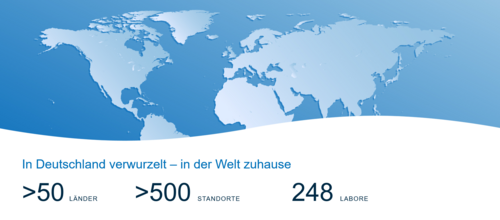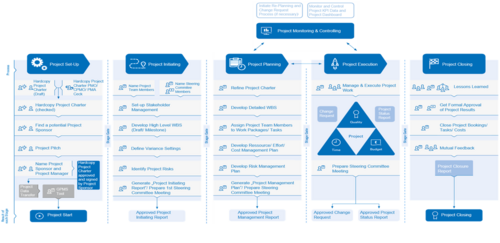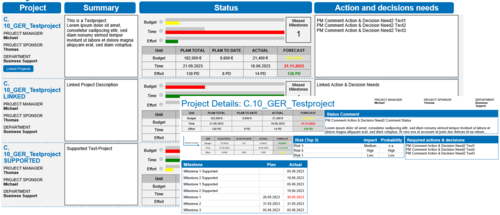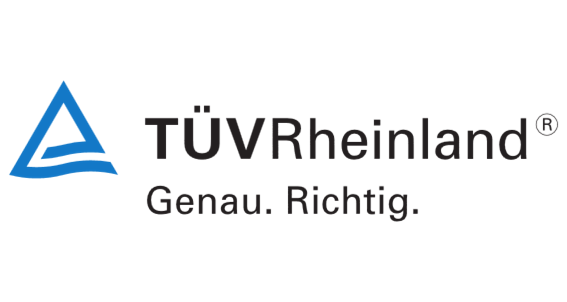Centre of the global application landscape for project management
Success story from TÜV Rheinland
At TÜV Rheinland, Projektron BCS is at the centre of the global application landscape for project management. It provides and receives important data in all business areas and offers effective project controlling. With the introduction of Projektron BCS, the daily work of employees has become much more standardised, optimised and user-friendly in many areas.
TÜV Rheinland - the interplay between people, technology and the environment
Many people in Germany associate TÜV Rheinland primarily with vehicle testing centres. In fact, TÜV Rheinland is a globally recognised testing service provider that has been ensuring safety and quality in various industries and sectors for over 150 years. With more than 20,000 qualified employees in more than 50 countries and an annual turnover of around 2.3 billion euros, TÜV Rheinland offers comprehensive services. These include the testing of technical systems and products, the support of technical and economic innovations, the training of people in various professions and the certification of management systems according to international standards. TÜV Rheinland works independently and trustworthily, thus promoting sustainability and fair trade along global flows of goods and value chains. TÜV Rheinland has been a member of the United Nations Global Compact since 2006, which campaigns against corruption and in favour of greater sustainability.
Projektron BCS in international use at TÜV Rheinland
Various areas of TÜV Rheinland rely on Projektron BCS: TÜV Rheinland's corporate IT is bundled globally and is the central IT service provider. However, business units and other functions at TÜV Rheinland also use BCS - not only in Germany, but worldwide. In total, almost 2,000 people work with BCS at TÜV Rheinland.
TÜV Rheinland starts the software implementation project for Projektron BCS in 2017. I myself was involved in the project as a tester in 2018. I extensively tested the software and, above all, our individual configurations of BCS. As a result, I got to know Projektron BCS very well and have been supporting the BCS application on a permanent basis since 2018. The more we introduced BCS in the company, the more colleagues supported me in my work in user support and configuration. There are currently five people in my team internationally. When support requests are received via the ticket system or if further customisation is required, we are responsible. We take care of the staging process, development on the dev instance and testing.
Harmonisation of global project management
Before BCS, there was no standardised tool for our project management. Today, this is Projektron BCS. This means that all projects are realised using Projektron BCS. The scope and duration of our projects vary considerably and range from a standard test as a small project to large projects with a duration of several years and over a hundred project participants.
The need for a central software solution arose from the desire to create a central database for all projects worldwide as part of our harmonisation efforts and to harmonise and modernise our IT landscape worldwide. In 2017, this desire ultimately led to the search for suitable project management software. As some of our colleagues were already working with BCS, the possibility of extended use was obvious.
We have been using Projektron BCS productively since 2018. Internally, we have defined a Global Project Management Standard (GPMS) for our project management, which is based on the international PMI standard. The tool defined in the GPMS is Projektron BCS.
Projektron BCS implementation - planned in BCS
We implemented the software according to an agile process model. We started using the software productively at a very early stage (initially the project planning function) and actually planned the BCS implementation in BCS. We then made adjustments and configurations step by step during use.
At the beginning, we migrated many ongoing and planned projects to BCS. This process is still ongoing today, as we are gradually using BCS in other TÜV Rheinland companies. From the time of introduction, new projects were only created and planned in BCS.
Projektron BCS training customised
At the beginning, we organised a large number of training courses for employees and project managers to facilitate the switch to BCS and increase acceptance. Many of these training courses were initially provided by Projektron GmbH consultants, customised to our individual configuration. Together with the Projektron trainers, we customised the content of the training courses to our specific needs.
To this day, we continue to offer training courses to teach new colleagues how to use the software. New employees apply for BCS access via our service portal and immediately receive a training plan tailored to their area of application and videos explaining the basics of using BCS. There is also the option of internal "Expert Project Management Training" as an online course.
Projektron BCS utilisation international, individual and diverse
The utilisation of various Projektron BCS functions differs. In one area, for example, time recording and holiday and absence management are now only handled in BCS. At TÜV Rheinland's internal services, project time recording is carried out purely via BCS.
We use Projektron BCS not only in German, but also in other language versions due to its international use.
The internally defined GPMS standard also defines the procedure for project planning and implementation. The course of the project is divided into different phases. We have configured a separate wizard for each phase, which queries the information required in each case. Among other things, the GPMS team is responsible for training employees in the use of BCS according to this customised configuration.
A project begins with the "Project initiating" phase, in which the project manager defines the project objectives, determines the T-shirt size of the project (effort estimate from XS to XXL), carries out a stakeholder analysis and a risk analysis, draws up an initial work breakdown structure and records important dates in the project calendar. All data is recorded in a report and additional files are stored in a file repository on the project. A specially configured wizard guides you through the individual steps of this phase.
This is followed by the "Execution" phase, in which the project managers are also supported by their own wizard. At the end of each GPMS stage, a report is generated that documents the results of this phase.
We use the Projektron BCS project portfolio management module to create our GPMS board report. In this report, the important projects are transferred into a portfolio and the elementary KPIs of these projects are clearly summarised for top management.
Versatile integration - interfaces
We began developing SAP interfaces at a very early stage, as we use SAP in many areas of the company, for example for order processing and invoicing. The most important of these is the interface for commercial data: All project-relevant information is maintained in BCS and a sales order can be generated from this in SAP at the touch of a button. The number that is generated from this in SAP is in turn recorded in BCS directly on the project. The employees post their expenses to the respective project in BCS and also close their bookings there. This data is transferred to SAP via another interface and can be billed there.
Conversely, we have various interfaces from SAP to BCS that transmit important KPIs, such as an interface for monitoring the liquidity of a project.
In addition to the interface to SAP, we have an interface to a survey tool that we use to carry out our customer satisfaction surveys after project completion. This enables us to start surveys directly from BCS. We have also implemented single sign-on so that our employees do not have to enter a password and can use a secure and modern login procedure.
There is also an interface to our file management tool, where we can store legally relevant files in an audit-proof manner. We also have an interface for transferring project times and one to our HR system. We use an Outlook interface to import appointments from Outlook to BCS so that they can be taken into account for resource planning.
If travelling is required as part of a project, we do not use the expense or travel cost model, but have set up the option of creating a trip in BCS for the respective project. BCS generates an ID, which we then enter in another tool in which we carry out the travel expense report. The travel expenses are then also displayed in the project thanks to the ID.
Outlook: Rolling out BCS in other companies
What I really like about BCS is that you can make a lot of customisations and configurations yourself. We have many different instances of BCS (staging environment for testing, dev environment for development, training environment, etc.). Only after testing has been completed are all the configurations rolled out to production on a fixed maintenance weekend each month.
The high number of users, projects and different configurations for our individual companies are currently having a negative impact on performance. It is also difficult to fulfil the different needs, requirements and wishes of our individual companies. We are therefore currently considering utilising the multi-client capability of BCS and separating the individual instances.
Since last year, we have been working on rolling out Projektron BCS in another company. This company is currently using the BCS invoicing module. While invoices were previously sent purely from SAP, it should now be possible to generate an invoice from BCS in SAP.











